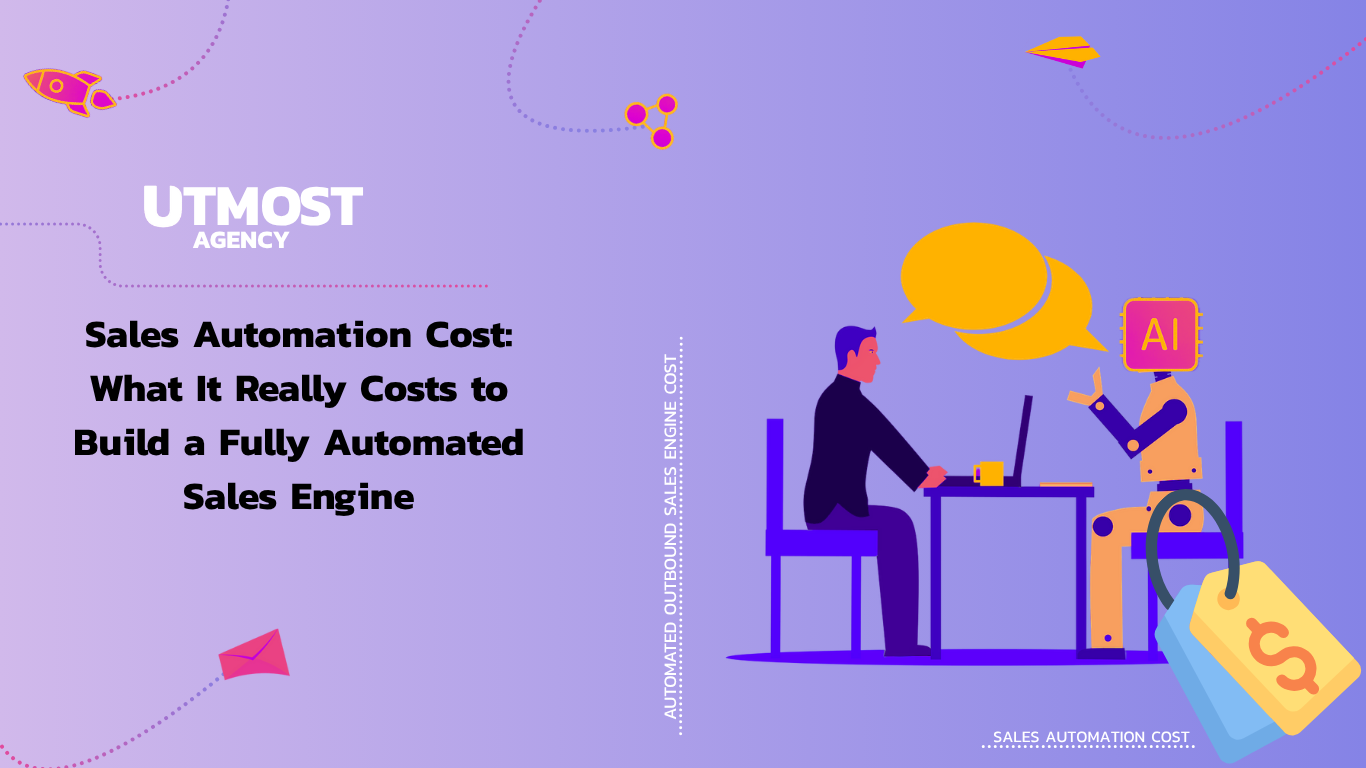
Sales Automation Cost: What It Really Costs to Build a Fully Automated Sales Engine
Learn how much it’ll cost you to automate your entire sales process. You’ll also understand how to build your sales workflows and what sales automation tools you need.
Table of Content
So, what’s the sales automation cost? How much does it cost to automate your entire sales processes, including your inbound and outbound sales functions?
At Utmost Agency, we build sales automation systems every day, and we believe you can safely ballpark the sales automation cost to be anywhere from $5000 to the tens of thousands of dollars, depending on your business industry, your target market, and the expert you are working with.
That’s surely too expensive and probably way more than you expected. Here’s why.
When people hear “sales automation”, most imagine a bunch of sales tools firing off cold emails in the background. Or, some just think about the big CRM tools and their many capabilities.
Even if you search right now for “sales automation cost”, CRM tools are all you’re going to find with their pricing.
But real sales automation is much more than that.
It’s about building, or rather, orchestrating a system, an entire GTM engine that finds the right prospects, generates personalized messages, reaches out at the right time, and makes sure your sales team only talks to the most qualified leads.
At Utmost Agency, we build these systems every day using Clay at the core. And in this post, we’ll walk you through the workflows, the tools involved, and what it actually costs to build a fully automated sales function, and more importantly, what you get out of it.
We’re not just going to throw a list of tools or a bunch of CRM solutions’ pricing at you.
Instead, we’ll show you how the system works and what kind of value it brings to your business, going from better pipeline quality and faster sales cycles to reduced overhead and little to no manual work.
We’ll break it down across three key areas:
- Outbound sales prospecting and multi-channel outreach automation
- Intent data and buying signals monitoring system + real-time outreach automation
- Inbound lead qualification and sales handoff automation
So, let’s get started.
Note: Struggling to connect with decision-makers in your target market?
We’ll run a completely done-for-you outbound campaign and automate your sales prospecting process to generate a pipeline with prospects ready to engage on autopilot.
Book a 15-minute call now to discuss your unique business needs and discover our flexible packages.
How much does it really cost to automate each function of your sales activities?
Now, let’s discuss each sales automation workflow. First, we will look at the tools involved, what each tool does, and what value they bring to your sales team.
The idea is to first show you sales work the workflows and how much it costs to implement, so that you can easily evaluate the business value for your company.
1. Outbound sales prospecting and outreach automation cost
Outbound sales prospecting and outreach is the process most sales teams think about automating, and rightly so, because it is where most teams burn out fast.
In most cases, businesses are either paying a team of SDRs to manually build lead lists, which costs A LOT, or relying on low-quality data that sends them in the wrong direction, which costs even more.
What we do for our clients at Utmost is build precision-targeted outbound engines inside and around Clay.
These are smart tables enriched with high-quality data, personalized messages, and campaign logic that runs across email, LinkedIn, and even phone.
First, let’s break down what this process entails and why it’s important so that the tools involved and their pricing make more sense to you.
-
Command center for the entire workflow (Clay)
Clay provides a no-code AI-powered spreadsheet UI that allows for everything from data enrichment, list-building, and automated messaging to logic-based action triggering.
Clay’s pricing is credit-based; for example, the Explorer plan is about $349/month (or $314/mo annual) for 10,000 credits.
Even the cheapest Starter plan is ~$149/mo (2,000 credits), and as you can expect, higher plans yield more credits per dollar.
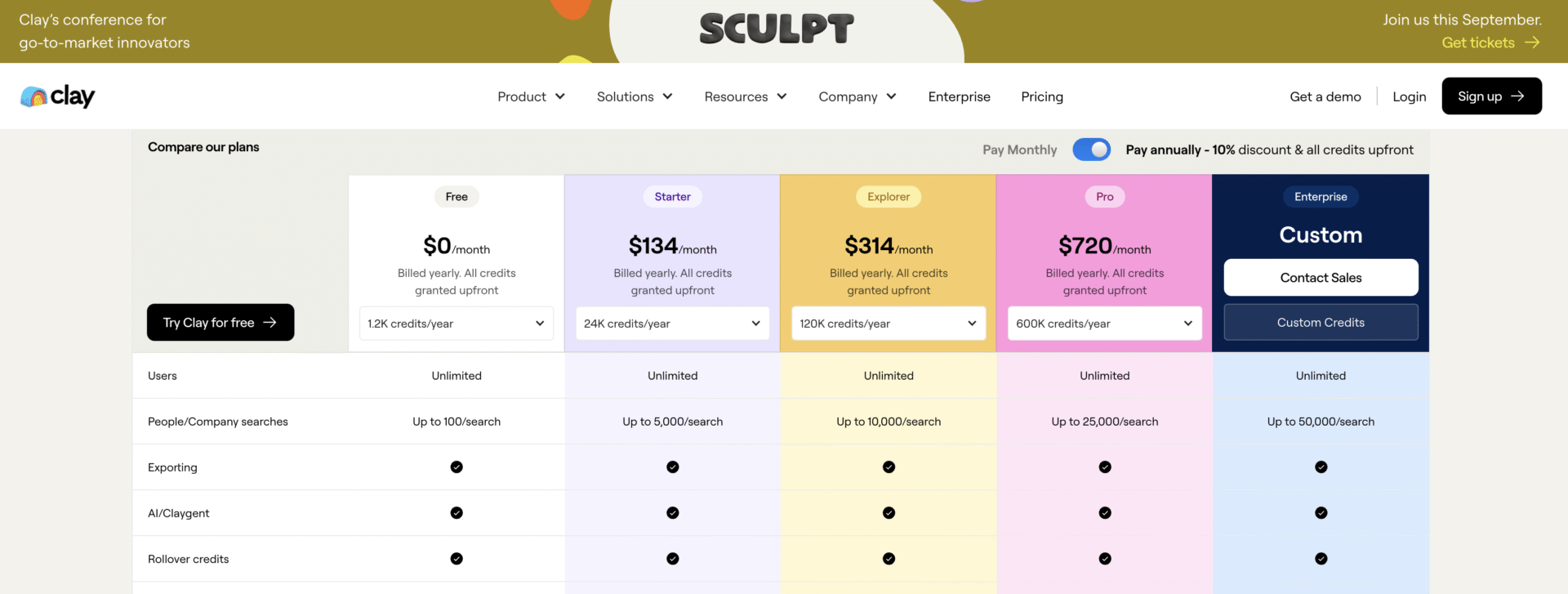
Obviously, Clay is not cheap. But it gets even more expensive when you have to rely on the native integrations it offers with the other 3rd-party tools that you’d want to integrate and use inside Clay.
For example, one of the many tools we like to integrate with Clay is Lead Magic, the tool allows us to enrich our lead list with contact information and more.
Now, if we are to use the native integration Clay offers, that costs a lot of credits per row and enrichment, and simply goes up to be more expensive than if we were to integrate them ourselves.
So, here we (and you should, too) use API keys when we don’t want to use Clay’s built-in (and more expensive) integration, or if Clay doesn’t support the tool we want natively.
The idea is to contain the high price for businesses on a budget.
At Utmost Agency, we do it this way because it allows us to offer more affordable pricing options to our customers, and that’s why we don’t own the Clay Expert Certification.
Because you need to spend some amount of monthly credits to have your name up there, and we prefer to design systems for our clients that cost less and work the same.
-
List-building tools
To improve lead data, you’ll need to subscribe to one or more data providers.
We like the idea of multiple data enrichment tools as well as prospect list-building sources because it offers our work multiple layers that ensure accuracy and thus effectiveness.
So, here, there is one sure tool for every business. The tools you choose and use should entirely depend on your business industry and ICP.
We see most marketers and outbound experts simply like to rely on popular options like Apollo.io, ZoomInfo, Lusha, and the likes.
The problem is that these tools are jacks of all trades and masters of none.
Even more importantly, our experience has proved time and again that they’re a lot less accurate compared to niche-specific sources, and there are some pieces of data that they just don’t find.
So, for a start here, we like to recommend two tools.
First, PandaMatch.io. It allows you to find look-alike companies. So, take a look at your best customers and try to narrow down the best defining criterias that pertain to them.
You can then use PandaMatch to find other companies that look the same.
PandaMatch has a Starter plan at about $79/month.
The second tool is Telescope.io (AI lead-gen), and it starts at $399/month for ~10,000 leads. Think about TryTelescope like ChatGPT, but find leads you wouldn’t find with popular tools.
We love it because it digs deep. It can help you find leads for ICPs as specific as “trucking companies in the Netherlands with more than 20 trucks”.
-
Data enrichment tools
So, after you build your list, you’ll have to enrich their contacts and personal information to build their profiles in Clay.
So, here, we recommend using a combination of LeadMagic, FindYmail, and FullEnrich, as we do.
Together, they help you build accurate lists (containing everything from email, phone contacts, LinkedIn profiles, and more), and one tool can pick up where the other fails.
You can then use Clay itself to enrich their technographic and firmographic data.
All the tools here (LeadMagic, FindYmail, and FullEnrich) are credit-based enrichment tools that sell bulk credits (e.g., 10,000 credits for $99.99), and everything searched is counted towards your credits.
Combined, expect these services to run hundreds of dollars per month ($500+), especially FullEnrich for phone contacts. Here is what their pricing looks like:
FullEnrich: $29 to more than $500, depending on your needs.

FindYmail: Anywhere from $0 to $249 based on your needs.
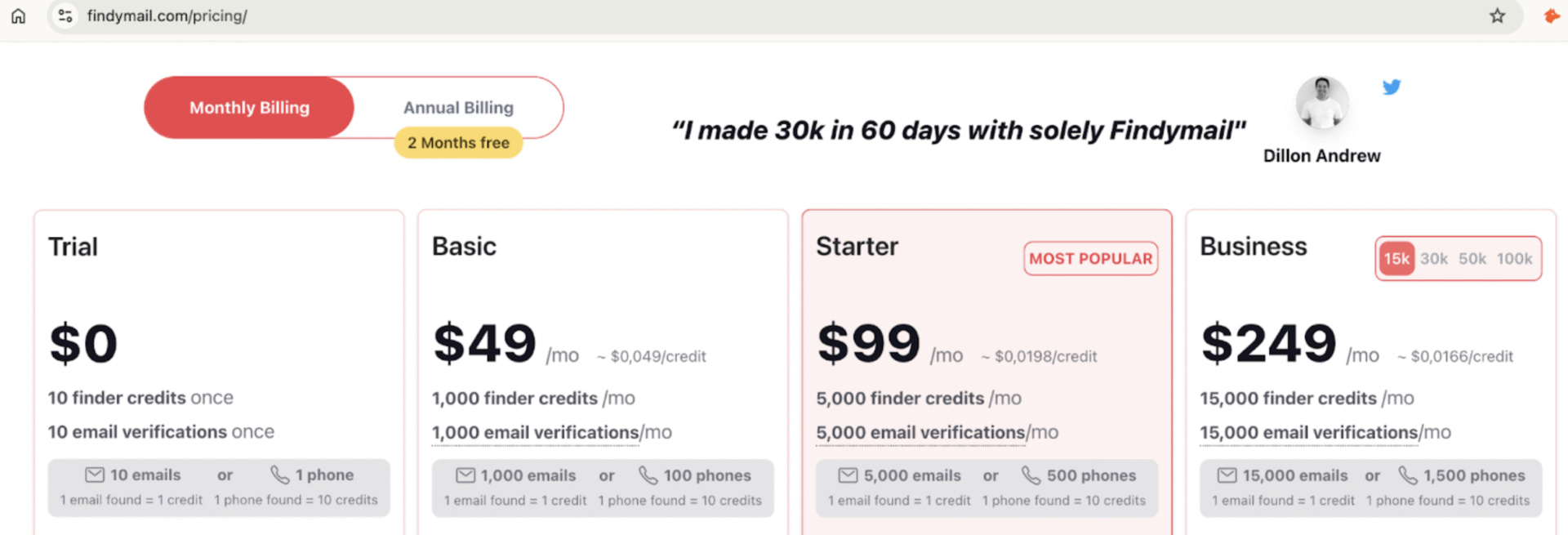
LeadMagic: $100 to $250

-
List hygiene and deliverability tool
Here again, we use a combination of tools. And keep in mind, it all happens in Clay through integration. This is very important because otherwise you’d be dragging CSV files around and manually copying and pasting information across systems and updating.
So, here, our workflow usually includes BounceBan (our favorite) with DeBounce and sometimes with ZeroBounce.
Combined, these tools will help clean your list by checking against blocked emails or do-not-lists, and much more to ensure deliverability and relevant outreach.
BounceBan offers unlimited free single email verifications in “Free Mode.”
For bulk or API usage, pricing starts at $21.25, and charges are based on successful verifications.
Their Sync feature (what we use), which continuously checks emails from CRMs, Clay, or lists, uses a monthly credit-based model depending on the number of unique emails processed.
DeBounce offers a pay-as-you-go model starting at $10 for 5,000 emails ($0.002 each), with bulk discounts down to $0.0003 per verification at high volumes.
They also provide 100 free credits on signup and optional data enrichment for 1 extra credit per hit.
ZeroBounce, on the other hand, charges $20 for 2,000 validations ($0.01 each) or offers subscription plans starting at $18/month with rollover credits and up to 18% savings.
-
Automated message generation tools
At this, you should have a clean list and be ready to start running campaigns.
Here, we use (and recommend) ChatGPT and Claude.ai’s native integrations in Clay to generate messages for each customer.
Bear in mind, these are not random messages; the message generation needs to be based on the enriched data you have sitting in your Clay tables.
So, they can use that information to create uniquely personalized messages for each lead and make relevant offers.
-
Inbox and sending domain tools
We recommend using ScaledMail for buying inboxes and sending domains. It lets you buy sending domains for both Google and Microsoft.
Scaledmail can cost anywhere from $45 to $259 based on your needs.
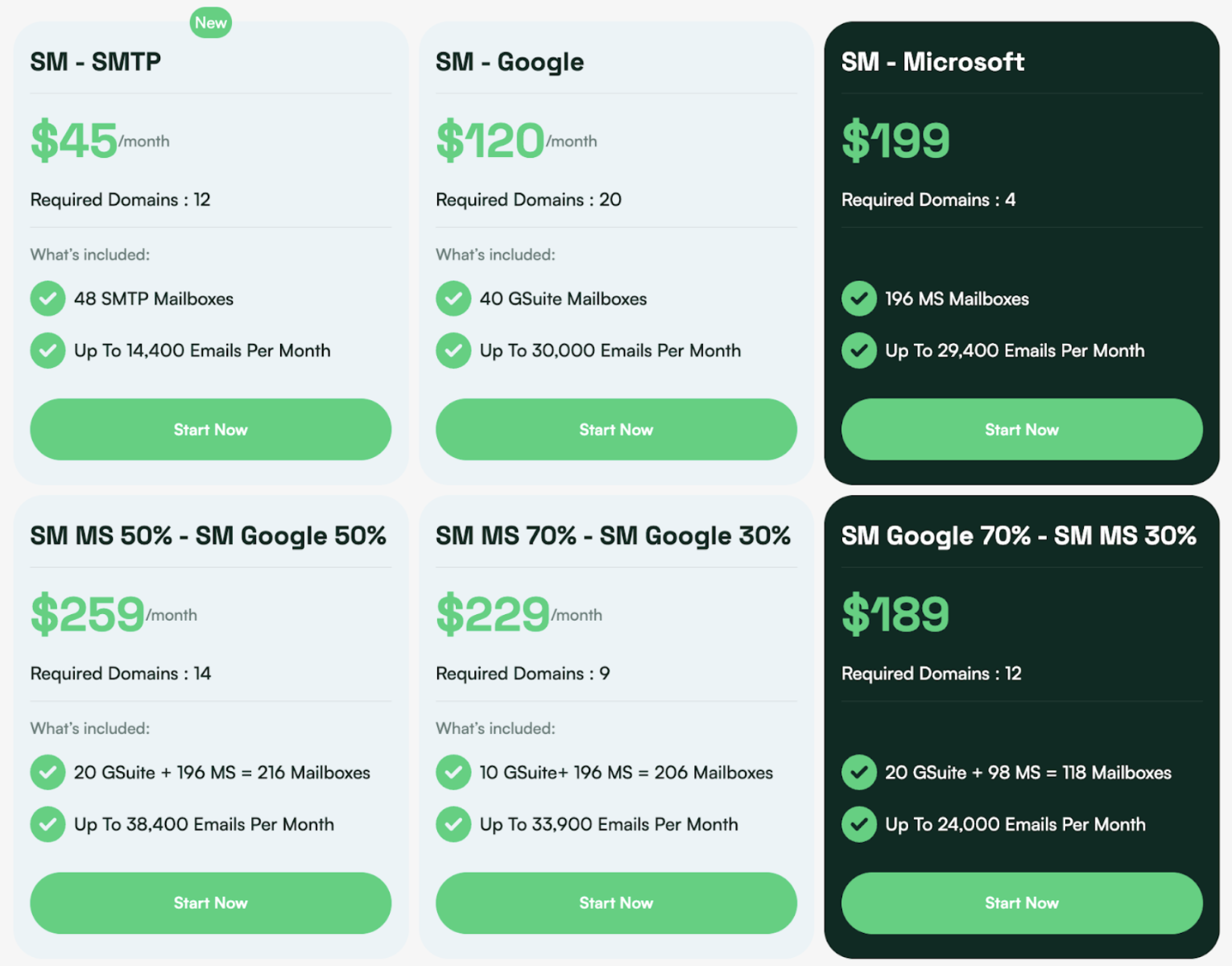
A big big mistake businesses make here is that they avoid buying sending domains and inboxes and simply rely on their primary email addresses to run campaigns.
This is highly risky and can end up hurting your main domain, your sending reputation, as well as your SEO. You can read our email deliverability guide to learn more about this.
-
Outreach automation tools
Here, we recommend using Instantly.ai as it automates sending and warming for email. More importantly, you can do it directly from Clay by integrating them.
Its Growth plan is about $37/month and lets you send ~5,000 emails per month. A more advanced plan (Hypergrowth) is ~$97/mo for up to 100,000 emails.
Other outreach platforms (e.g., Woodpecker, Lemlist) are in a similar $30–$100+ range per month.
For LinkedIn, the best tool is Periodix. Its pricing goes anywhere from $50 to $150 based on your needs.
Although Periodix does not directly integrate with Clay. So, you’ll need a workflow automation tool that ties them together, which takes us to the next category of tools.
-
Workflow automation tool
Platforms like n8n or Zapier tie tools together. When you can’t connect them natively or through APIs. For this, we’re fans of n8n.
n8n’s cloud plans start around $20–$50 per month for small teams (Starter $20/mo, Pro $50/mo). This handles tasks like moving leads from Clay to your CRM or email tool. Here is a little bit what the entire workflow is composed of:

Here is a summary of the pricing for all the tools involved in here:
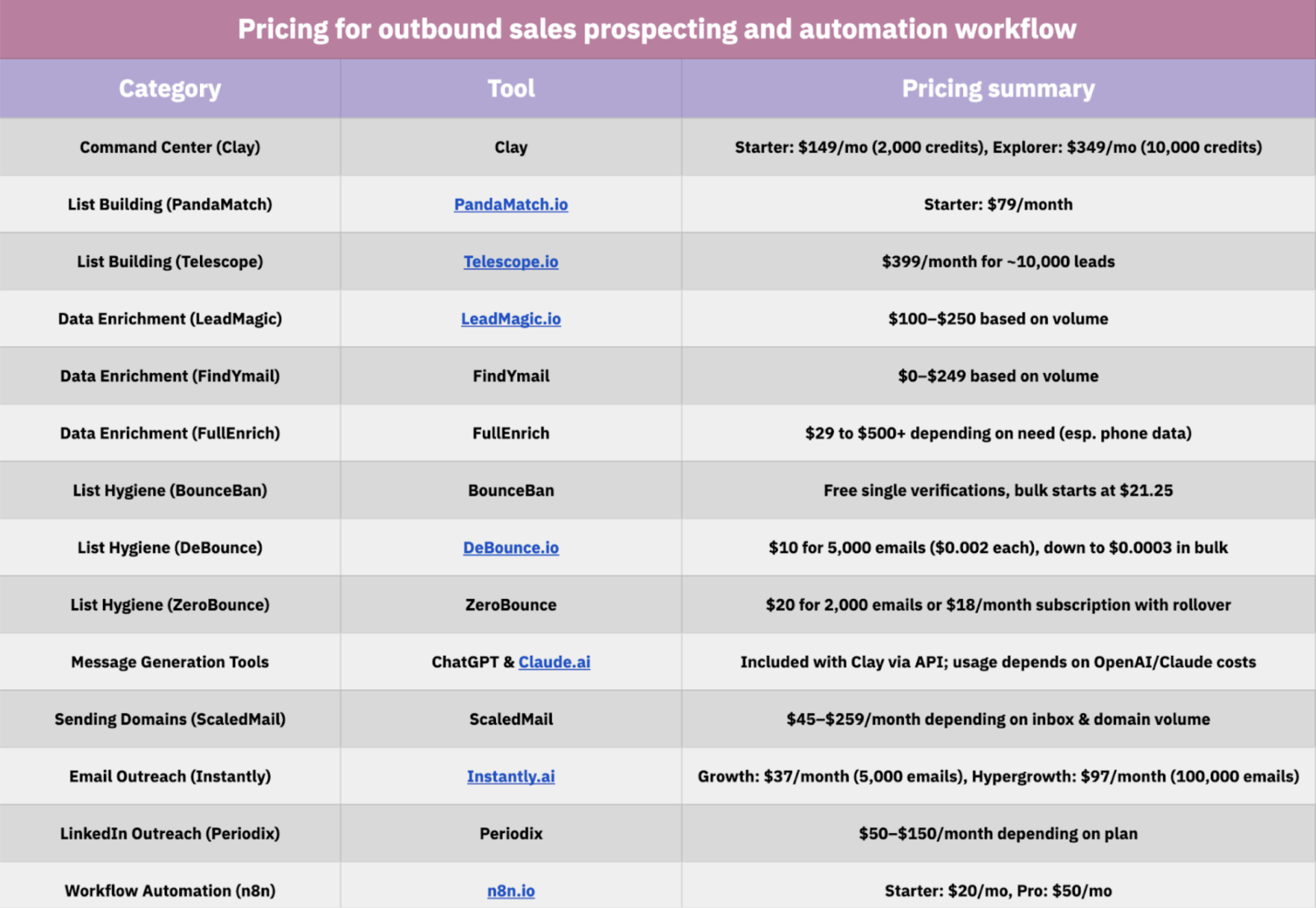
Now, $1,200/month may seem like a lot until you compare it to a junior SDR who costs you $4,000–$6,000/month plus management time, training, and burnout risk.
We also tried breaking down the sales automation costs based on the three main business tiers:
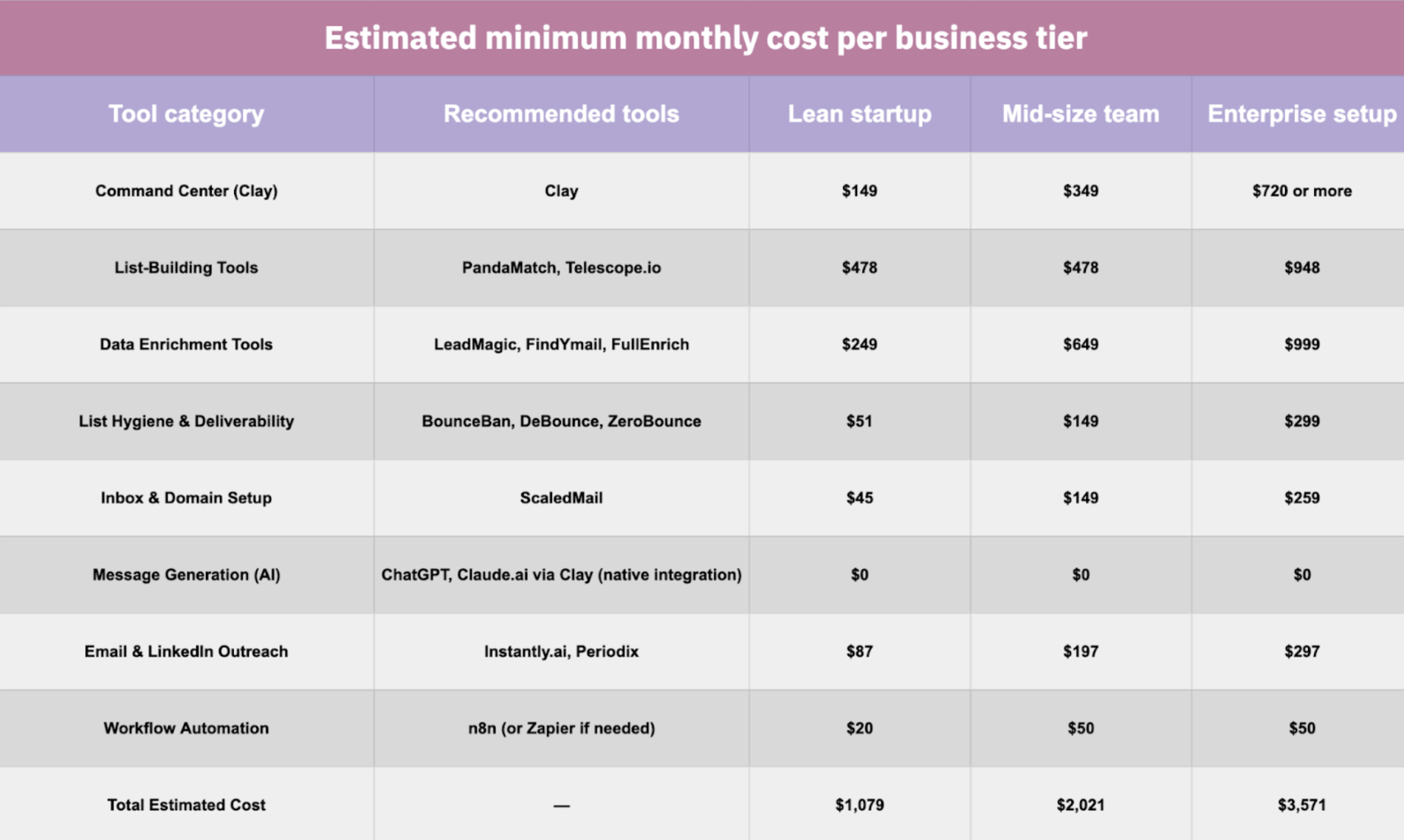
With this system, you’re not just “sending emails.” You’re building a system that:
- Automatically finds prospects who match your ideal customer profile.
- Enriches their info with verified emails, company details, and insights.
- Generates personalized messaging using AI tools like ChatGPT.
- Reaches out on multiple channels and tracks all engagement in one place.
- Notifies your team when it’s time to hop in and close the deal.
The business outcome for you here is more meetings booked with the right people, less manual grunt work, and a lower cost-per-lead over time.
You don’t waste time chasing cold, unqualified leads. Your system prioritizes the best prospects and gets you in front of them faster than your competitors.
Also, keep in mind that you may need other subscriptions (e.g., CRM, warm-up servers, LinkedIn accounts), but the above cover the core pipeline.
Compared to hiring extra SDRs for an average of ~50k–60k$ per year with all the risks involved, we believe these software costs are modest.
Note: Struggling to connect with decision-makers in your target market?
We’ll run a completely done-for-you outbound sales campaign and automate your sales prospecting process to generate a pipeline with prospects ready to engage on autopilot.
Book a 15-minute call now to discuss your unique business needs and discover our flexible packages.
2. Sales intent data and buying signals automation cost
This is where things get exciting. At this point, you’d already have a solid outbound system running in Clay. But there’s more to sales.
The AI surge has brought about new ways to uncover sales data and find opportunities to beat competitors in your industry, and you need to be there.
So, you need an intent data and buying signal system as well.
So, basically, our definition of intent data is that instead of going out and trying to convince people to care, intent data helps you find people who already do but haven’t entered your buying cycle or made any contacts.
These are companies showing signs they need your product, growing towards needing, making business decisions that suggest they’re going to need, or are about to buy something like your solution.
At Utmost, we set up automated intent signal workflows using Clay in tandem with tools like Apify, PhantomBuster, and Trigify. These workflows run 24/7 and alert you whenever someone in your market shows a buying signal.
The best part is that it works by building upon the already orchestrated and automated outbound prospecting and multi-channel outreach system.
So, all you have to do is build a system that finds, scrapes, and pushes the data into Clay, then the workflow unfolds.
Let’s discuss in further detail.
So, here, the one tool category you’re going to need will be signal scanning and trigger tacking tools.
Why you shouldn’t trust standalone intent data source tools
First, here, when you read intent data and buying signals, you probably thought of tools like Bambora, ZoomInfo, Cognism, and the other big names often referred to as intent data sources.
We don’t mention or use them because we don’t believe in them.
If you’ve been reading our blog for some time, you know we take intent data tracking seriously, and for us, it is all about data quality, accuracy, and timeliness.
Basically, these tools offer simplistic data, like tracking and reporting on article views or IP address visits. We don’t believe that’s real intent data.
These are surface-level signals that only tell you that someone from a certain company visited your website or read an article.
Even worse, some tools (Bambora, for example) work by establishing a baseline of normal content consumption for companies.
When a company reads more about a topic that’s outside of that baseline, the tool then flags it as “intent.” We don’t believe it is.
Basically, with these tools, you never have any contextual understanding that suggests actual buying intent. So, that is why we build a different system and recommend you do, too.
Let’s give an example to show you what we do and the business value involved in it for you.
For a client offering AI-powered furnishing solutions, we monitor and scrape RSS feeds from sites like Multi-Housing News, Chicago Yimby, Property Week, and many other topically and contextually relevant sites.
These are sites that publish whenever a new property gets acquired or when a company is making acquisitions.
So, every time a new article is published, the article is pushed into Clay. We identify if the article was about an announcement of a new property development project, if so, what the name of the project is, who the developer is, and what their website and contact person is.
Clay finds all this automatically. This is where the Clay workflow we built for outbound sales automation comes into play as well.
So, with the workflow, we automatically enrich contact details, generate an email or LinkedIn message based on the collected intent data, and send it to the contact person. Here is what it looks like:

So, it’s a specialized monitoring system that captures opportunities at the exact moment when developers are planning furnishing needs for new properties—a perfect alignment of timing and need, and we are almost sure to win the deal.
This is the type of logical and intelligent systems we believe you should design for intent data and buying signal tracking.
-
Intent data and buying signal-scanning and trigger-tracking tools
So, now, back to our system, to catch buying signals, you’ll use scrapers and listening tools. For this, we recommend PhantomBuster and Apify.
PhantomBuster automates social/LinkedIn triggers (likes, comments, follows, etc.) and new-job notifications.
For example, we use PhantomBuster to scrape and collect information about SDR job postings on LinkedIn, which suggests the company may need or could use our expertise and service, so we push this data into Clay, the workflow unfolds, and we reach out automatically.
Its starter plan is roughly $69/month for 20 hours of run time and limited “phantoms” (Pro plans are $159+).
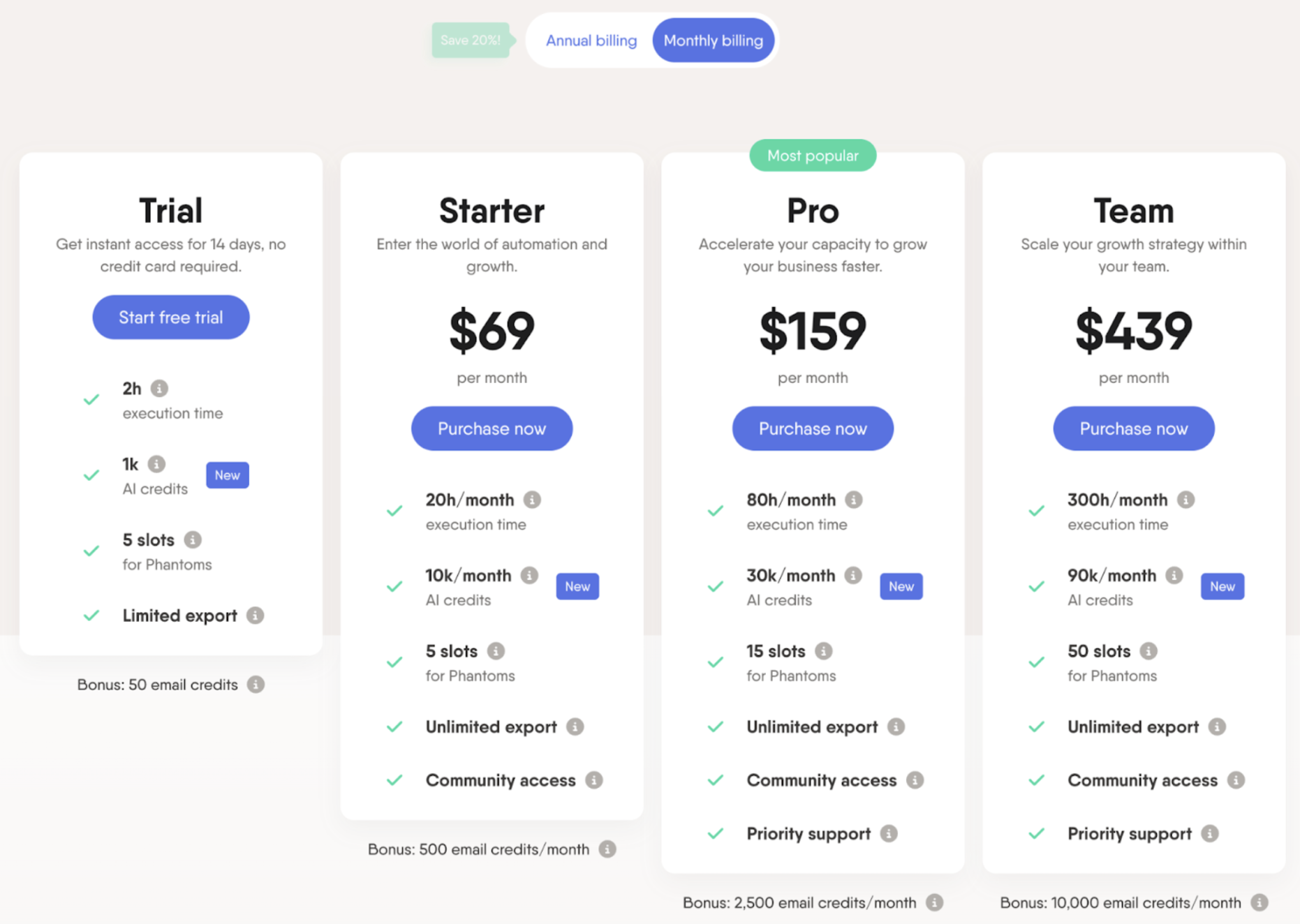
Apify provides general web scraping and data extraction. This can be anything like scraping information on your website or industry-specific sites like Crunchbase.
Apify’s starter plan is $39/month (with $39 of platform credits).
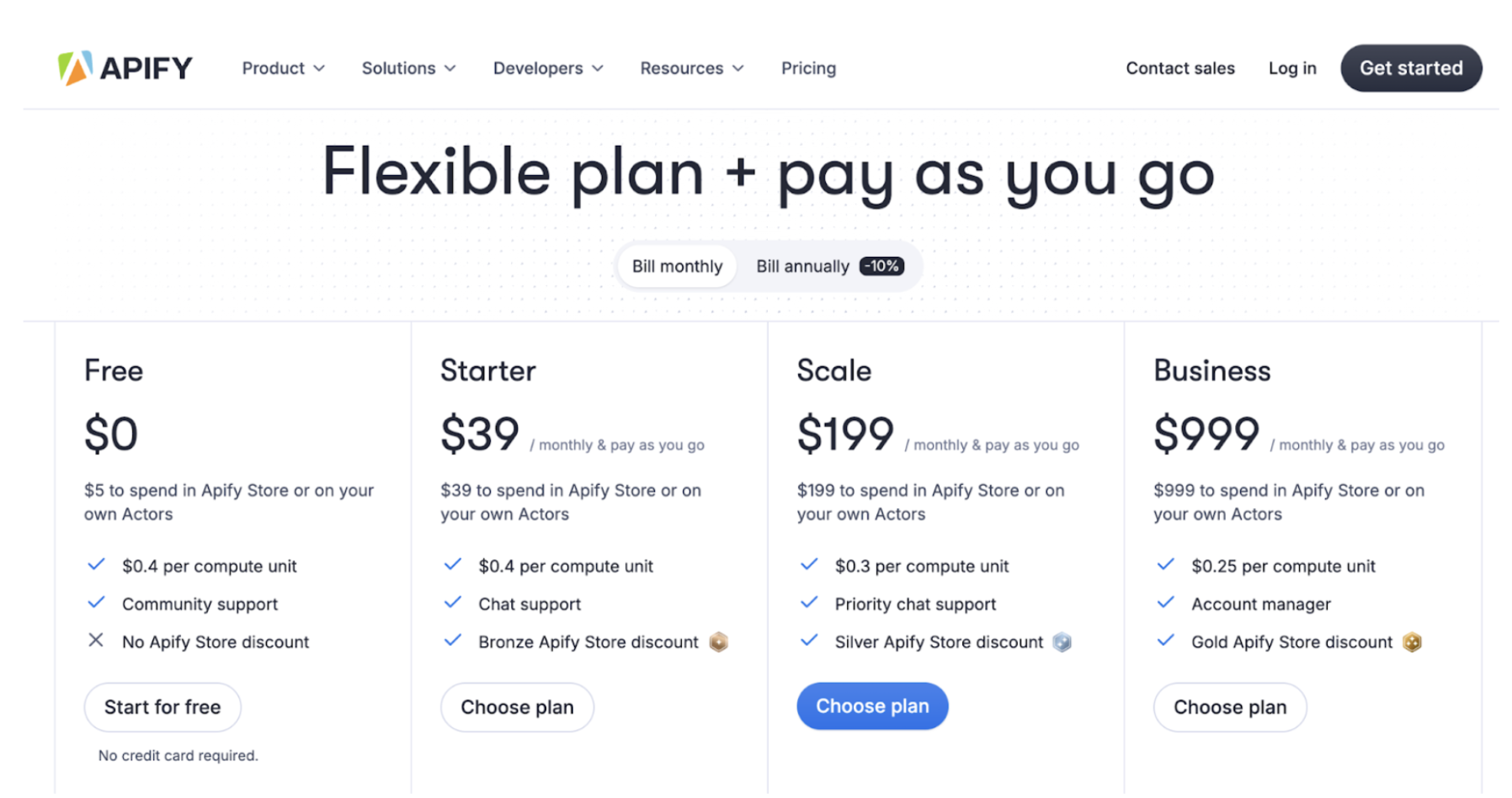
Trigify.io is an excellent alternative to PhantomBuster, and given that we like to add accuracy layers to our work, we use both together and recommend you do too. It’s excellent for social listening and engagement tracking.
Its pricing starts around $149/month (Essential plan).
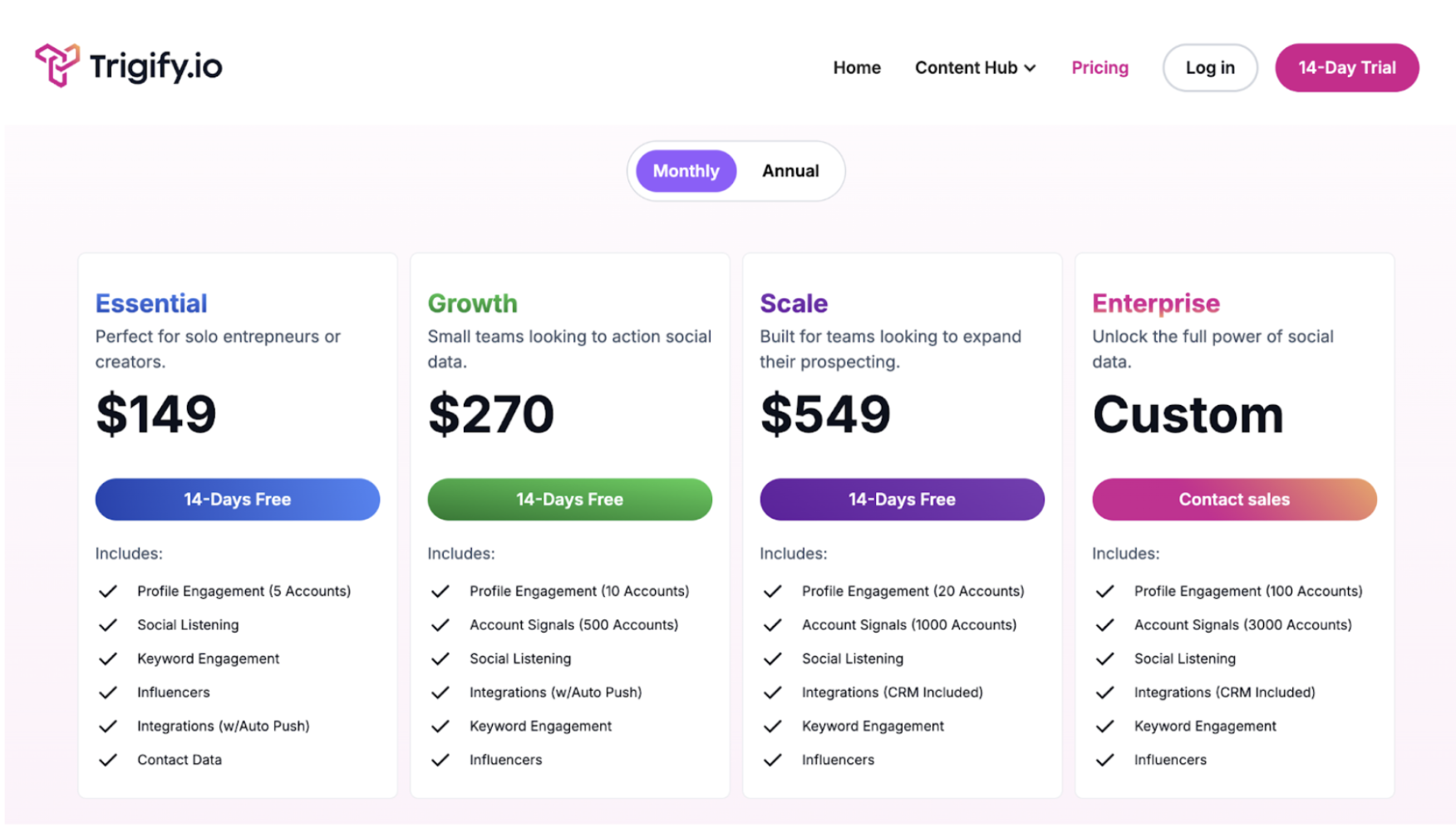
We also monitor triggers and signals via free or premium RSS feeds or Google Alerts. These tools don’t usually cost much, and pricing is typically around $50. Here’s a breakdown of the costs:
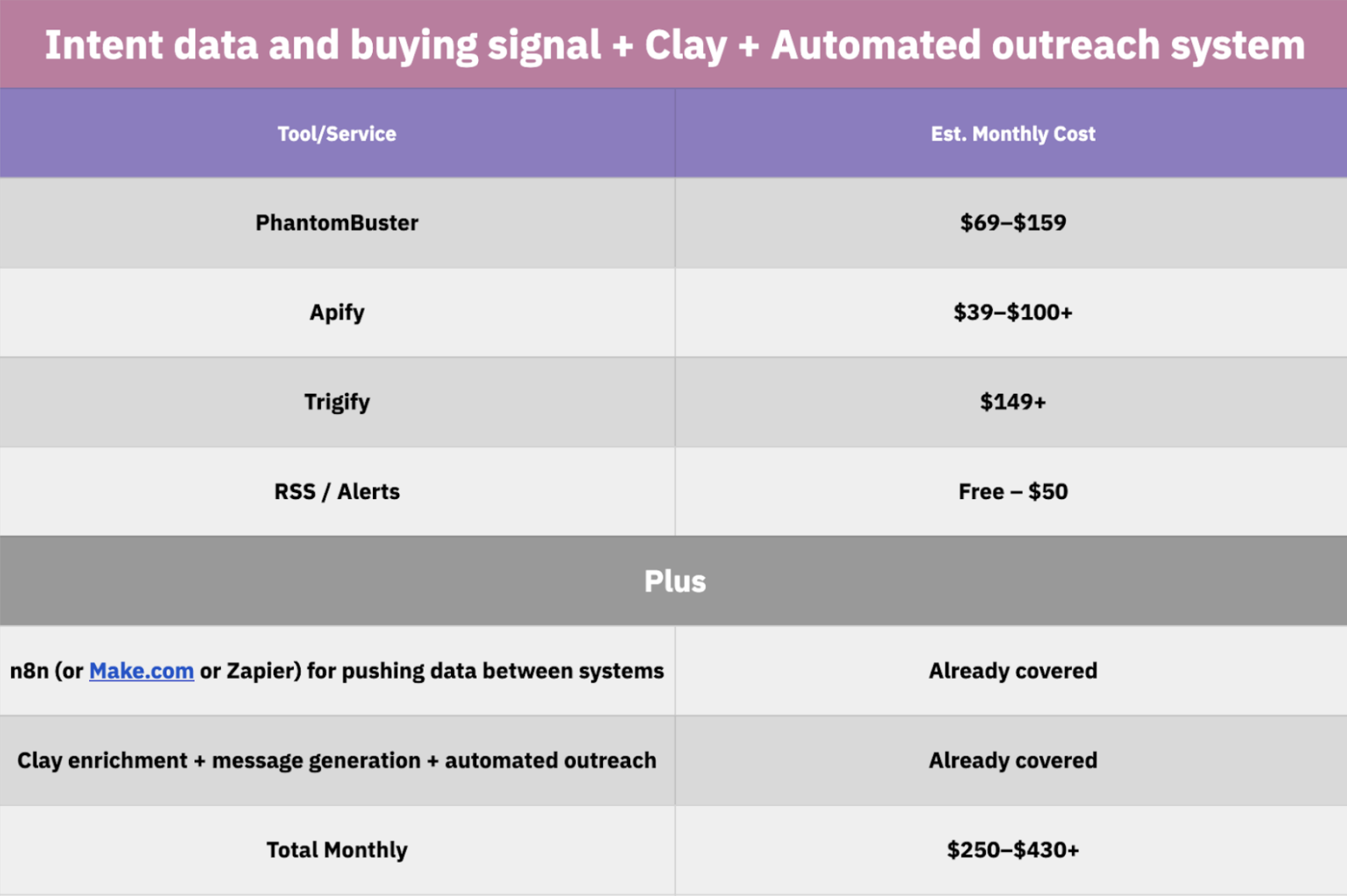
So, these signal tools do add dozens to hundreds per month in software costs. In return, they let you engage prospects at just the right time and yield far more leads than purely manual research would.
Instead of sitting back and hoping leads show up, you’re proactively watching your market for real signals of intent. When one happens:
- The data is scraped and sent to Clay automatically.
- Clay enriches the lead and identifies the right contact person.
- A tailored message is generated and sent via LinkedIn, email, or your sales reps get a Slack notification with a prospect dossier and go for a happy dial.
You connect with leads before they start actively shopping, giving you a serious first-mover advantage.
When done right, this will bring your business shorter sales cycles, higher response rates, better close rates, and larger deal sizes (because you’re solving urgent problems).
Note: Struggling to connect with decision-makers in your target market?
We’ll run a completely done-for-you outbound campaign and automate your sales prospecting process to generate a pipeline with prospects ready to engage on autopilot.
Book a 15-minute call now to discuss your unique business needs and discover our flexible packages.
3. Inbound sales automation cost (inbound lead qualification and sales handoff
Now, the third and last sales function we believe you should also automate is inbound lead qualification and sales handoff. This is a pain for several businesses for a lot of reasons.
Most companies let inbound leads sit in a spreadsheet for weeks or pass them to reps without any context.
Sales reps then waste time manually sorting through leads, qualifying and reaching out to them (either too early or too late) with little to no return.
Automation fixes that.
Contrary to most sales automation or outbound lead generation agencies, we believe you should extend the automation engine to your inbound leads, so that every form fill, demo request, or social interaction is:
- Captured instantly.
- Enriched with company and contact data.
- Qualified using a custom scoring model.
- Routed to the right rep in real-time.
- Followed up with relevant messaging immediately.
Here are the tools involved.
-
Qualification workflow tools
You can use tools like n8n or Zapier ($20–$50/mo) to connect your webforms/chatbots to Clay and your CRM. That means your inbound leads (form fills, demo requests, chat inquiries, inbound calls) can be instantly routed and scored.
If you want to scrape additional intent, for example, set up a scraper for your money pages to find and collect information about visitors who spend time on pages like your pricing pages, comparison pages, and service pages, we recommend Apify or RB2B.
For Apify, you pay the same $39+ Apify plan.
RB2B costs anywhere from $0 to $129 and more based on your needs.
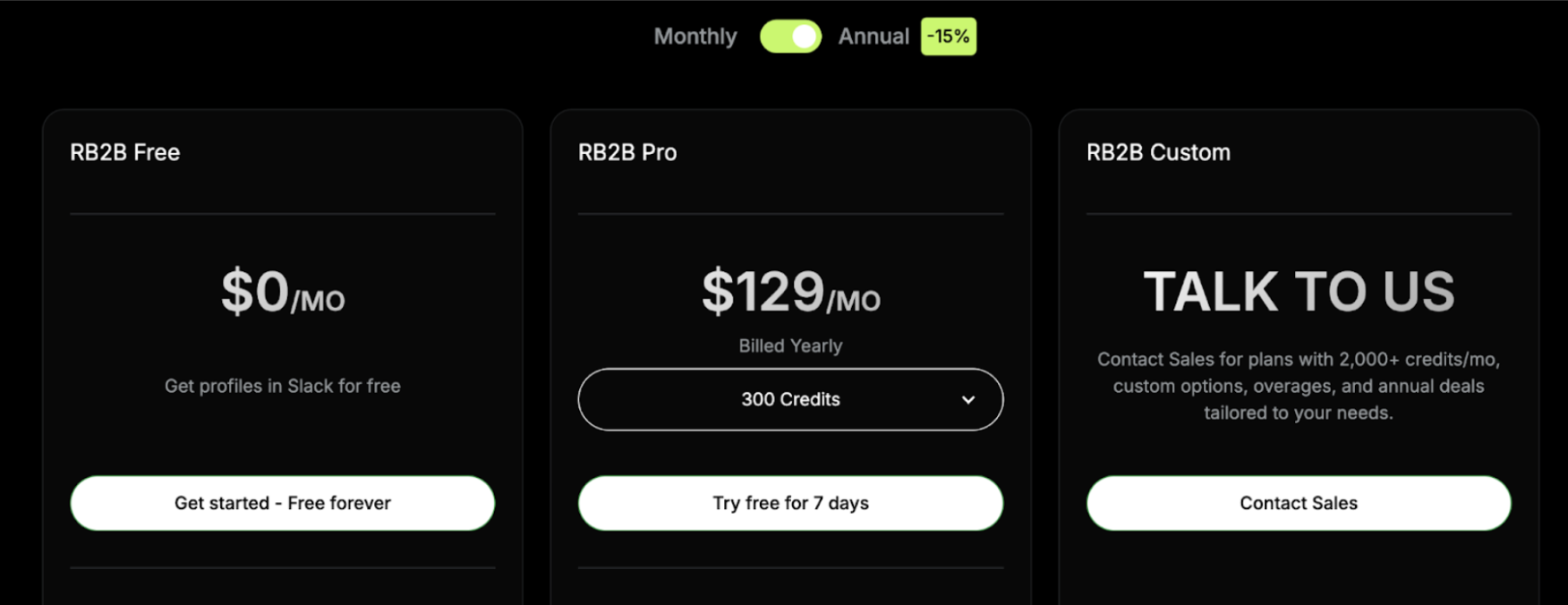
RB2B lets you see who’s visiting your website, what page they’re visiting, and build a complete profile of them. Although, it only works for US-based companies and audiences.
Also, if your company or one of your leaders has an active and interaction-generating LinkedIn page, we recommend that you use PhantomBuster to record all interactions and push them into Clay.
So, here again, you collect all the data and push it into Clay.
Clay will enrich incoming contact info (e.g., email domain, profile details), and you can then define and assign scores or tags to quickly qualify leads and send qualified leads to your sales reps or send them personalized messages through the same system we described earlier.
Here’s a breakdown of the pricing:
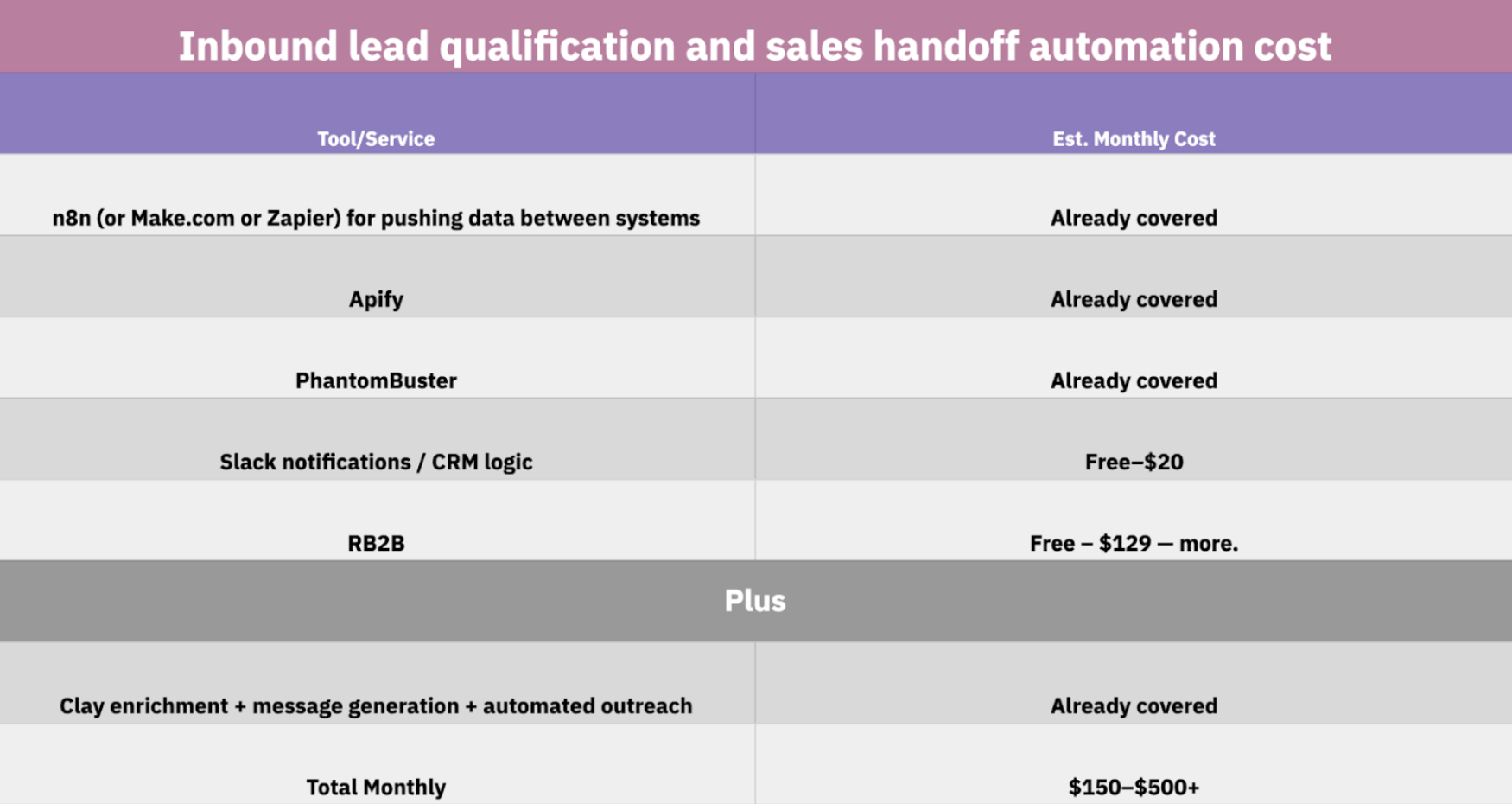
So, this automation dramatically cuts lead response time and saves your sales reps from wasting hours filtering junk leads or copying data.
When set up right, the moment someone downloads your whitepaper or fills out a demo form, the system goes to work and finds:
- What company they’re from
- How big they are
- What tech they use
- Who else works there
- Whether they recently raised funding or are hiring
Then it can score the lead automatically, notify the right rep in real time, and tee up a personalized first message.
That means your sales team focuses only on sales-ready leads. No more wasted time chasing junk. No more manual data entry. No more “let me Google this person real quick.”
You’ll:
- Respond to inbound leads within minutes
- Increase your lead-to-meeting conversion rate
- Keep reps focused on deals, not admin
How much will a sales automation expert or agency cost you?
You’ve probably noticed that we’ve only been talking about the tools involved in the different workflows and their pricing.
We haven’t actually discussed the expertise it takes to bring those systems together into one sales orchestration that generates a consistent and reliable pipeline.
Because that’s a considerable cost as well. Even more expensive than the cost of the tools together.
Obviously, Clay is the main system here, and because of that, you’re going to need a Clay expert or expert agency to help you further make sense of the system, their value for your business, and how to actually build the systems.
Clay experts and agencies typically cost between $3000 going north of $10000, and even $16000.
This includes companies or experts that both run campaigns, are responsible for results, and pay for the tools themselves, as well as those who only come in to build the systems and move on.
Hire Utmost Agency to help you automate all your sales functions
So, there you have it.
Fully automating sales from outbound to intent signals to inbound follow-up requires a mix of paid tools. You should expect to invest on the order of low- or high-thousands of dollars per month for a serious setup.
It can seem expensive, but compare that to the cost of even one extra sales rep (~$4–5K/month salary) and the efficiency gains become clear.
Automation not only saves labor costs but also measurably boosts conversions by engaging prospects at the right time. In short, the “sales automation cost” is typically outweighed by the ROI of having a leaner, faster-moving sales engine all backed by data-driven workflows.
At Utmost Agency, we build and orchestrate automated sales systems for our clients. We are a team of sales automation and lead generation experts who help you understand your target market and engineer a GTM system that helps you generate leads on autopilot.
Note: Struggling to connect with decision-makers in your target market? We’ll run a completely done-for-you outbound campaign and automate your sales prospecting process to generate a pipeline with prospects ready to engage on autopilot. Book a 15-minute call now to discuss your unique business needs and discover our flexible packages.